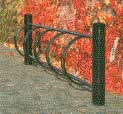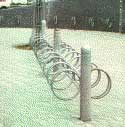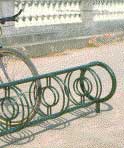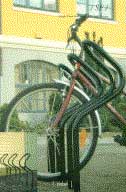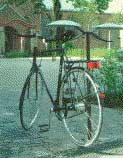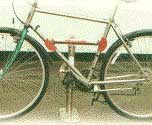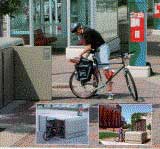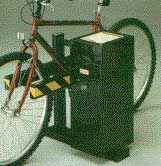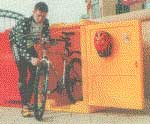|
|
|
| Home | |
|
|
|
|
|
|
Cycle
Parking Facilities Suitable for Installation in LB Ealing, London
Response from Ealing Cycling Campaign December
1998 Contents
1.
Basics a)
Location The
overriding priority for most cyclists is to park close to their
destination. If there is a lamp-post or railing closer to the entrance
of the building they are visiting, then it will be used in preference
to any cycle parking facilities. Ideally, cycle parking should be
just outside the entrance to the building, and certainly closer
than the nearest car parking spaces (excluding disabled parking).
Security
is important, and a well-lit, busy location where the bikes are
easily visible is preferred to a dark alley, or the back of a building.
Close to the entrance of a building is ideal. A
major concern is placing further obstacles in the way of people
with visual impairment. The pavement is already an assault course
for them. Perhaps tactile paving could be used to caution people
with visual impairment to expect parked cycles. The RNIB Joint Mobility
Unit (0171 391 2160) may be able to give advice on this. You
should always be able to cycle right up to the cycle racks. (At
the moment you have to pass a 'No Cycling' sign to get to the cycle
racks next to the tennis courts in Pitshanger Park. Perhaps the
sign should be removed.) b)
Security & Support. Bicycles
can cost as much as £2000+, but whatever the price, all cyclists
prefer to chain the frame and at least one wheel to an immovable
object. Any cycle rack that fails to meet this basic requirement
won't be used. The rack also needs to support the whole bike. Cycles
can easily fall over in racks which just hold the front wheel, resulting
in a scratched frame, or worse, buckled wheels. 2.
Report on cycle stands a).
Veksø
b)
Mawrob
In
terms of practicality and ease of use the classic Sheffield stand
is hard to beat. A plastic coating is preferred by cyclists as it
offers some protection against scratching. High Sheffield stands
have the advantage that the saddle may be leant against the upright,
thus protecting the paintwork of the bike. The stand also offers
the opportunity to lock both the rear and front wheels to an immovable
object as well as the frame. Longer Sheffield racks offer more support
- particularly to tandems. N.B.
No consideration has been given to the relative cost of the various
stands as we don't have that information. 3.
Report on cycle lockers Advantages:
A hidden bike is more secure than one out in the open. It is protected
from the rain and it is possible to store panniers, helmet and waterproof
clothing in the locker. Disadvantages:
May be a security risk - you can get a lot of explosive inside one
of these, so their use may be suspended during times of terrorist
activity. The keys are removable, so could be copied and then used
to steal bikes. You also need to have the correct amount of change
on you, or your own lock. Comments:
These are particularly suitable for overnight cycle parking. They
would be particularly suitable outside the front entrances to blocks
of flats where cycle parking may be difficult (often landlords prohibit
cycle parking in the hallway which is where most regular cyclists
would leave their bikes). Cycle parking facilities like this should
be made a requirement for all new residential developments - with
at least one cycle space per bedroom. And the facility should be
closer to the front entrance to the building than any car parking
spaces. They
may also have a use outside stations. They would be ideal for the
commuter who could keep a bike at his or her destination station
and cycle the rest of the journey into work. At the end of the day
they could leave the bike overnight knowing it would be secure.
a)
Cycle Works Limited
b)
Theme bins International Ltd.
4.
Suggestions The
classic Sheffield stand is difficult to beat and should provide
the backbone of cycle parking in the borough. However we appreciate
that it is not the best looking stand and by installing them everywhere
Ealing would become just like 'Anytown, UK'. The
place to look for variety is not Europe (where people tend to have
less expensive bikes and are not so concerned with security), but
America. A number of American manufacturers have web sites, and
the best is Derovations Corp (http://www.dero.com/.) where you can
see a range of imaginative stands that meet the requirement that
you can a) lock the frame and at least one wheel to the stand, and
b) the stand supports the whole bike. Some of their more imaginative
ideas - like the large fish - would be ideal for 'fun' sites like
leisure centres and parks, while more formal ideas would suit business
districts. Cycle racks can be more than just practical, they can
be interesting pieces of sculpture, and certainly arts centres and
museums should have more creative designs. This web site has pictures
of bike racks snapped all over the US and Germany, and is well worth
a visit. Other
American manufacturers of interest are: *
Bikelid: Error! Bookmark not defined.Who produce a bike stand with
a hinged moulded plastic cover that protects the bike from the rain.
Imaginative, unusual, but may be prone to vandalism. *
Cora: Error! Bookmark not defined.produce racks that look like coat
hangers which seem to be popular in Canada. The advantages are you
can lock the frame and at least one wheel to the rack, and it uses
less metal per bike than the Sheffield stands. However they don't
offer as much support to the bicycle. *
A final suggestion comes from the cycle friendly town of Boulder
in Colorado where they have found a way of re-cycling car steering
wheels as cycle stands. Error! Bookmark not defined. *
5. The National Cycle Network - Guidelines and Practical Details,
Published by Sustrans *
Chapter 9 - Signing, Parking and Other Details *
Notes *
1. Sheffield stands enable cyclists to secure both frame and wheels
to the stand. *
2. A minimum gap of 0.8m should be left between stands to allow
two cycles per stand. If a narrower gap is used, capacity may be
reduced. *
3. All steelwork to be provided with adequate corrosion protection. *
4. Street furniture should be utilised for parking cycles wherever
appropriate eg. railings and tree guards. Cycle parking sign Diag
No. 968 may be fixed to the relevant street furniture. Care should
be taken to avoid obstructing the footway. This should not be seen
as a substitute for the provision of cycle parking stands. *
5. Parking facilities should be conveniently located, secure, easy
to use, adequately lit and well sign posted. Weather protection
should be considered. *
6. Generally, parking should be placed within a populated, well
supervised area and as close to amenity locations as possible. *
7. Wall bars are an alternative fixing device which may be considered
where there is limited pavement available for a Sheffield Stand.
Hitching rings or loops are a form of wall bar which may have aesthetic
attraction at some locations. *
8. A minimum spacing of 1800mm for wall bars will allow one cycle
per wall bar. If the number of wall bars is increased then this
will allow more locking options for the cyclist. The fixing should
be embedded in the wall at about 750 mm above ground level. *
9. The use of single wheel holders provides less security and can
cause damage to cycles. *
10. In rural areas or at historic sites, the standard Sheffield
stand as shown may be intrusive. In such circumstances an equivalent
degree of security can be provided by stands based on the same principles
but of a form more in keeping with the location. *
References *
1. Local Transport Note 1189 Making Way for Cyclists (S) *
2. CTC Technical Note - Cycle Parking (exerpt follows) *
Bicycle Size: The space required for a parked bicycle may be taken
as 1.8m length and 0.6m width across handle bars *
On Carriageway: Road space can be given over to cycle parking, for
example by removal of car parking bay. The cycle stands should be
protected from encroachment by motor vehicles *
Footway: Cycle parking on the footway should be located where it
is unlikely to cause obstruction to pedestrians *
Off-Street: Cycle parking should be in prominent locations near
entrances to major attractions. Appropriate standards for cycle
parking should be imposed on new developments *
6. Cycle-Friendly Infrastructure *
Guidelines for Planning and Design - published by CTC (Cyclist Touring
Club) *
(a useful exerpt) *
"Part V: Cycle parking and public transport *
Cycle parking *
19.1 Why provide facilities? *
19.1.1 The need for cycle parking *
Many a potential user is deterred from riding a bicycle through
fear of having it stolen. However, carefully planned provision of
secure parking facilities can do much to encourage new users, and
make existing cyclists more confident about leaving their bicycles.
In addition, safe and convenient cycle parking at cyclists' destinations
helps to make cycle routes and other facilities well used. *
19.1.2 Well planned cycle parking facilities can confer security.
They can give a much neater and less cluttered appearance than the
use of railings, lamp posts and drain pipes. They also reduce the
risk of obstruction to pedestrians, especially visually impaired
people. The costs of installation and maintenance of cycle parking
facilities are appreciably less than those for cars, and ten bicycles
can be parked on the space needed for the parking of one car. *
19.2 Legal powers to provide cycle parking facilities *
19.2.1 Section 63 of the Road Traffic Regulation Act 1984 empowers
local authorities in England and Wales to provide cycle parking
in roads and elsewhere. *
19.3 Cyclists' requirements from parking facilities *
19.3.1 Parking facilities should be conveniently located, secure,
easy to use, adequately lit and well signed, and, if possible, sheltered.
This is particularly important for long term parking. Convenience
is particularly important for short-term parking. *
19.3.2 To promote security a cycle parking facility should make
it possible for the frame and, if possible, both wheels to be locked
to the fixture. Stands which support a cycle only by supporting
one or both wheels are unsatisfactory; they are insecure and can
result in damage to the bicycle. It is very desirable that the parking
area should be overlooked by occupiers of a building nearby or be
in clear view of passers by. Properly lit facilities will also enhance
personal and bicycle security. *
19.4 Location and installation *
19.4.1 Cycle stands should be situated close to the destinations
they serve, preferably in locations where motor vehicle access is
restricted. This deters theft using vans etc. Stands hidden away
in a dark recess, or at the back of car parks, will not be attractive
to users. It is important to try to site stands as close as possible
to building entrances, to enhance convenience and security for users.
There is also the symbolic importance of making cycle parking more
prominent and convenient than car parking. Such decisions give a
clear message that the role of the bicycle is being taken seriously. *
19.4.2 Cycle stands should be placed carefully in relation to their
surroundings, It is often better to have several small groups of
stands than one big group, depending on the space available. Appearance
is greatly helped by incorporating cycle stands into wider environmental
improvement or repaving schemes, if such an opportunity presents
itself. Care should be taken to ensure that stands do not obstruct
pedestrians, especially people with disabilities, or incorporate
dangerous projections. *
19.5 Cycle parking standards *
19.5.1 Local authorities should stipulate suitable facilities for
cycle parking in giving planning permission for new developments
and redevelopments, in line with the recommendations of PPC13 (DoE/DOT
1994). *
Paragraph 4.17 states that: *
"Authorities should encourage the provision of secure cycle
parking at public transport interchanges, including railway stations
and park and ride facilities, to increase the opportunities to use
cycles in combination with public transport and car sharing. Provision
of secure cycle parking facilities should be sought in all major
developments and in town centres, and at educational institutions." *
Existing businesses should also be encouraged to provide cycle parking
facilities. *
19.5.2 Oxford and Bristol have produced detailed standards relating
cycle parking provision to floor space. Milton Keynes has integrated
cycle parking ill general parking standards. In York, the developer
is required to make a commuted payment to the local authority if
full provision cannot be made on site. Examples of cycle parking
standards are available in a Technical Note produced by the CTC. *
19.6 Short and medium term parking *
19.6.1 Requirements and recommended designs *
Short term cycle parking facilities are for visits of around 30
minutes or less at locations such as libraries and shopping centres.
Priorities are security, ease of use, and accessibility. Sheffield
stands and wall loops are recommended, preferably situated in frequent
small groups as near to the destination served as is practical. *
These should be clearly signed and well lit. *
19.6.2 The Sheffield stand enables the cyclist to secure both frame
and wheels to the stand without risking damage to the bicycle, and
provides good support for the machine. The stands should be 750mm
high and a minimum of 700mm long. A minimum distance of 1000mm should
be left between stands to accommodate two bicycles per stand. Stand
ends should be embedded in concrete or welded to parallel bars at
ground level creating a "toast-rack" formation. Adequate
space should be left at both ends of the stand, where possible,
to get cycles in and out easily. If a change of level is involved,
a short ramp rather than steps should be provided. This needs to
be steep enough to deter abuse by drivers, whilst being gentle enough
to make it easy to push a bicycle up or down it. Detailed guidance
on Sheffield stands, installation standards and suppliers has been
produced by the London Cycling Campaign (1995). *
19.6.3 Wall loops (or locking rings) are simple, cheap and may be
easier to fit in where there is a substantial length of wall and
limited pavement or other space for Sheffield stands. Small but
convenient and useful parking areas can thus be provided. Moreover,
they are virtually maintenance free. They must be securely fixed
to masonry. Their disadvantage is that to secure the wheels of the
bicycle as well as the frame requires an extremely long chain, thus
only limited security is offered. The loops should be 750mm from
the ground, project no more than 50mm from the wall, and be a minimum
of 1800mm apart. Signing is useful to show that cycle parking is
welcome. *
19.6.4 The use of "butterfly" or single wheel holders
is not advised, nor is the provision of concrete slots. These designs
provide little security and can lead to damage to the bicycle. *
19.7 Long stay parking *
19.7.1 Requirements and recommended designs *
Long stay parking is required for commuter cyclists' parking and
visits in excess of around two hours. The user expects additional
security as well as protection from the weather and may be prepared
to pay for these features. Cycle lockers or supervised cycle parks
are more appropriate for long stay parking than unsupervised Sheffield
stands as the latter have no facilities for storage. However, the
availability of luggage lockers nearby may overcome this drawback. *
19.7.2 Cycle lockers can be very secure, provided that they are
under regular surveillance. They also have the advantage that they
enable cyclists to store accessories such as pump, lights and waterproof
clothing. They are however, more expensive and can be unsightly.
Cycle lockers have been successfully installed in multi-storey car
parks in Nottingham and Plymouth, in positions where they can easily
be seen by car park attendants, and at railway stations in the West
Midlands by the passenger transport authority, Centro. Cycle lockers
can be operated by coin or token, or secured by the cyclists's own
lock. Credit cards or "smart" cards also offer potential
for safe and convenient use of lockers. Alternatively, lockers can
be reserved on a weekly, monthly or annual season ticket basis.
It is important that the lockers should be clearly signed, both
in the building and in its vicinity, to make drivers as well as
cyclists aware of their existence. They should also be available
late at night. *
19.7.3 Supervised provision is a common form of continental commuter
cycle parking, often as part of a shared facility with cars, for
example on the ground floor of multi-storey car parks or in special
premises at some railway stations. It again offers increased security,
but without the additional cost of installing lockers. * 19.7.4 At work places, locked cycle sheds are often a good arrangement. Employees will have a key to the external door and stands should be provided inside so that individual cycles can be locked securely." |
||||||||||||||||||||||||||||
